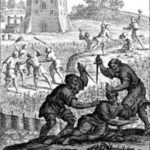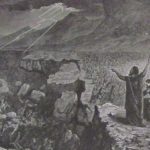We run our website the way we wished the whole internet worked: we provide high quality original content with no ads. We are funded solely by your direct support. Please consider supporting this project.

Did God Kill King Saul?
When we approach Scripture with the assumption that it is all God-breathed for the purpose of bearing witness to Christ, even the most trivial contradictions in Scripture can acquire theological significance. This is what I argue in Cross Vision. Here I want to illustrate this by briefly discussing the theological significance of a curious discrepancy in one of the biblical accounts of King Saul’s death.
In 1 Chronicles, we read that after Saul was gravely wounded in a battle with the Philistines, he implored his armor-bearer to kill him so he would not be captured and tortured to death by his enemies. The armor-bearer could not bring himself to do this, however, so Saul decided to take his own life (10:3-4). Interestingly enough, the author goes on to explain that Saul died because he “did not keep the word of the LORD” and did not “inquire of the LORD,” but instead “consulted a medium for guidance.” For this reason, the author concludes, “the LORD put him to death and turned the kingdom over to David …” (vss. 13-4, emphasis added). The obvious question is, how can this author claim that Saul killed himself while also claiming that the Lord killed him?
One could of course explain this conflict by proposing that this author/redactor spliced together different authoritative traditions that contained conflicting accounts of Saul’s death. Alternatively, one could account for the discrepancy by appealing to any number of exegetical considerations.
But the discrepancy acquires a much more profound significance when we reflect on it in a crucicentric way. As a judgment of Saul’s rebellion, Yahweh had withdrawn his protection of Saul, thus allowing spirits to torment him. He also had allowed Saul to sink deeper and deeper into his self-chosen sin as he consulted a medium at Endor (1 Sam 28; cf., Deut 18:9-14) and foolishly headed into battle without Yahweh’s instruction to do so and without his protection. Yet, while Yahweh was not responsible for Saul’s sinful decisions or for the self-destructive consequences of these decisions that resulted in his suicide, Yahweh nevertheless assumed responsibility for them by allowing himself to be depicted as doing what he merely allowed. In this way, the portrait of the Lord putting Saul to death can be understood as a literary crucifixion, pointing to the crucified God who takes responsibility for the sin of the world.
Image: “Death of King Saul”, 1848 by Elie Marcuse (Germany and France, 1817–1902)
Category: General
Tags: Cruciform Theology
Related Reading

Part 4: An Alternative Cross-Centered Approach
Image by Karl Pang via Flickr As I mentioned in Part II of this review, I am deeply appreciative of the fact that Flood grasps the centrality of enemy-loving non-violence in Jesus’ revelation of God. And while many, if not most, of the depictions of Yahweh in the Old Testament are consistent with this revelation, I…

Confronting the Divine Montage
The superiority of Jesus’ revelation over a montage view of God (see previous post) is captured when Paul and the author of Hebrews utilize an analogy of a shadow verses reality. Paul instructs his disciples not to “let anyone judge you by what you eat or drink, or with regard to a religious festival, a…

The Violent Vineyard Owner: A Response to Paul Copan (#8)
In my previous post I addressed two of the three parables that Paul Copan argues present God in violent ways. Today I will address the third, which is the parable of a vineyard owner with hostile tenants (Matthew 21:33-41; Luke 20:9-13). This parable differs from the previous two parables. Whereas the previous parables deal with…

A Coming Storm
There is a storm beginning to brew on the horizon. It is a debate among Evangelicals about the violent depictions of God, stirred up largely by Eric Seibert’s Disturbing Divine Behavior. Here is a post that sounds “the clarion call.” The debate is presently around two options. Option #1: Traditionalists argue we must simply embrace…

Jesus, the Center of Scripture
Paul declared that Jesus was nothing less than the very embodiment of all of God. This distinction of “all of God” is important for us to understand what it means for us to see Jesus and God rightly. Battling proto-gnostic teachers who were apparently presenting Christ alongside other manifestations of God, Paul declares “in Christ…

Four Principles of the Cruciform Thesis
In the second volume of Crucifixion of the Warrior God, I introduce how four dimensions of the revelation of God on the cross (as introduced in this post) lead to four principles that show us how to unlock aspects of the OT’s violent divine portraits and thus disclose how a given portrait bears witness to…
